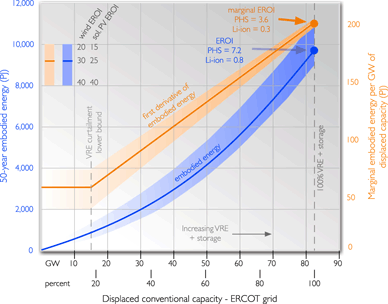A Framework for Incorporating EROI into Electrical Storage

Author: Graham Palmer
Citation: Palmer, G. 2017. Biophysical Economics and Resource Quality 2(6) doi:10.1007/s41247-017-0022-3
Abstract: The contribution from variable renewable energy (VRE) to electricity generation is projected to increase. At low penetration, intermittency can usually be accommodated at low cost. High-penetration VRE will displace conventional generation, and require increased grid flexibility, geographic and technology diversity, and the use of electrical storage. Energy return on investment (EROI) is a tool that gives greater weight to the principles of energetics over market prices, and may provide a long-term guide to prospective energy transitions. The EROI of electrical storage may be critical to the efficacy of high-penetration renewable scenarios. However, there is no generally agreed upon methodology for incorporating storage into EROI. In recent years, there have been important contributions to applying net-energy analysis to storage, including the development of storage-specific net-energy metrics. However, there remains uncertainty as to how to apply these metrics to practical systems to derive useful or predictive information. This paper will introduce a framework for evaluating storage at a system level. It introduces the surplus energy-storage synergy hypothesis as a general principle for exploring the role of storage. It is argued that the useful energy available to society is determined by both the net-energy of the energy source and the stored energy as stocks. This hypothesis is translated across to electricity systems with the use of electrical reliability indices to evaluate the value of storage. A case study applies the framework to a suite of VRE simulations. The case study was modelled as a limiting case of VRE plus storage, and is therefore not intended as a comprehensive cost-optimised solution to high-penetration VRE. A shift from an electrical system based mostly on energy stocks to one based mostly on natural flows is constrained by the quantity of storage required, and the quantity of VRE overbuild to charge the stores. The application of the framework shows that the value of electrical storage and overbuild exhibits a marked diminishing returns behaviour at rising VRE penetration and therefore the first units of storage are the most valuable. The framework is intended to stimulate further research into using EROI to better understand the role of VRE and storage in prospective energy transitions.